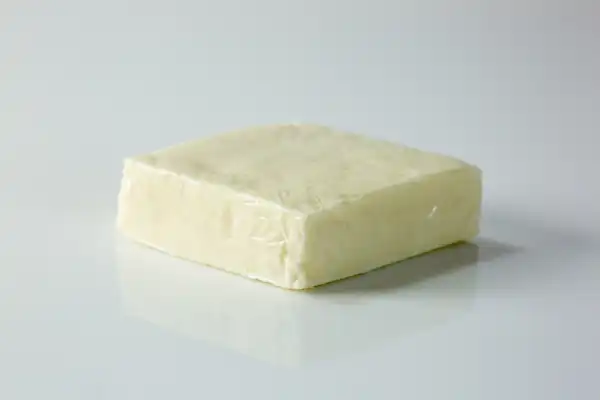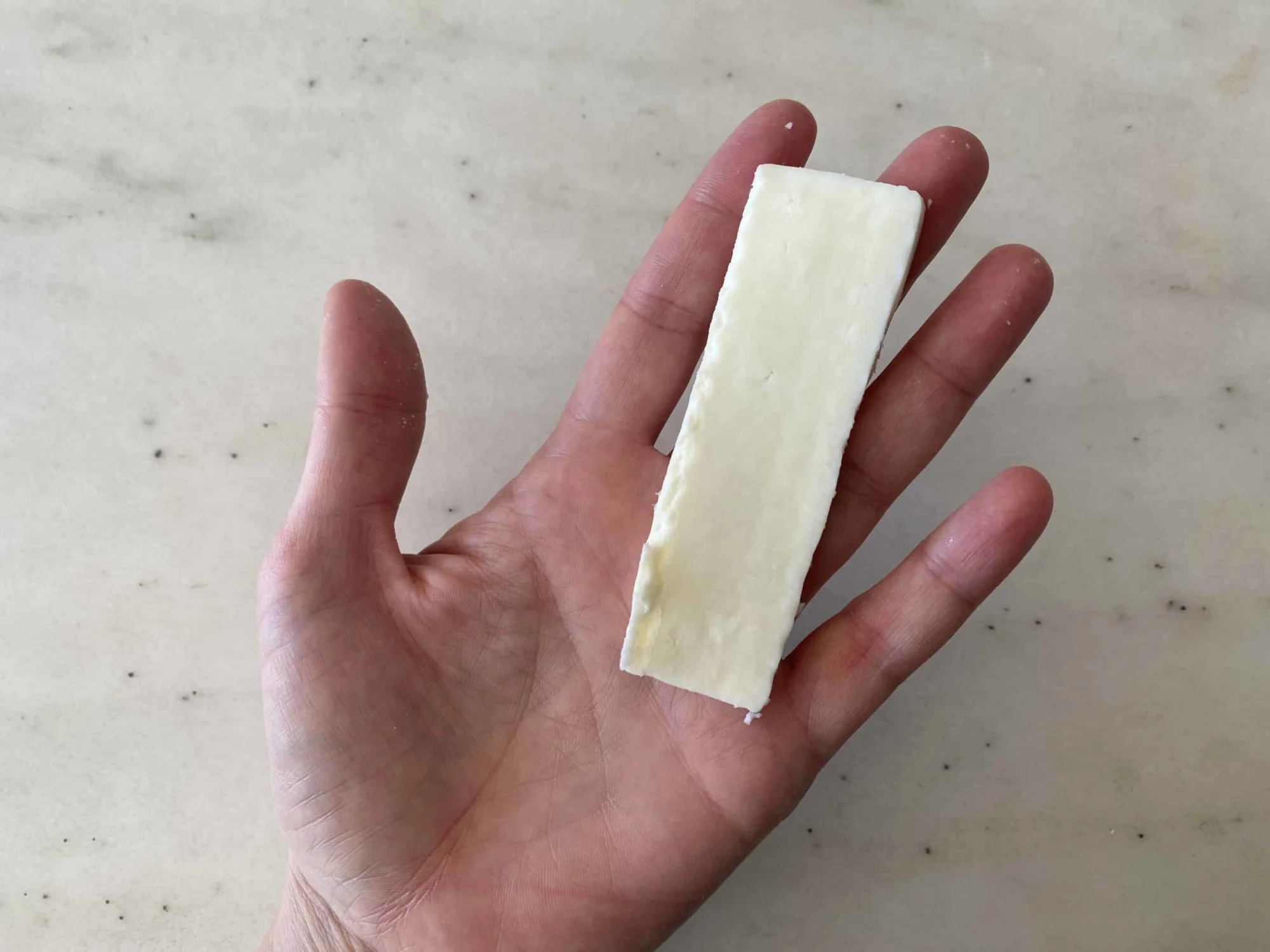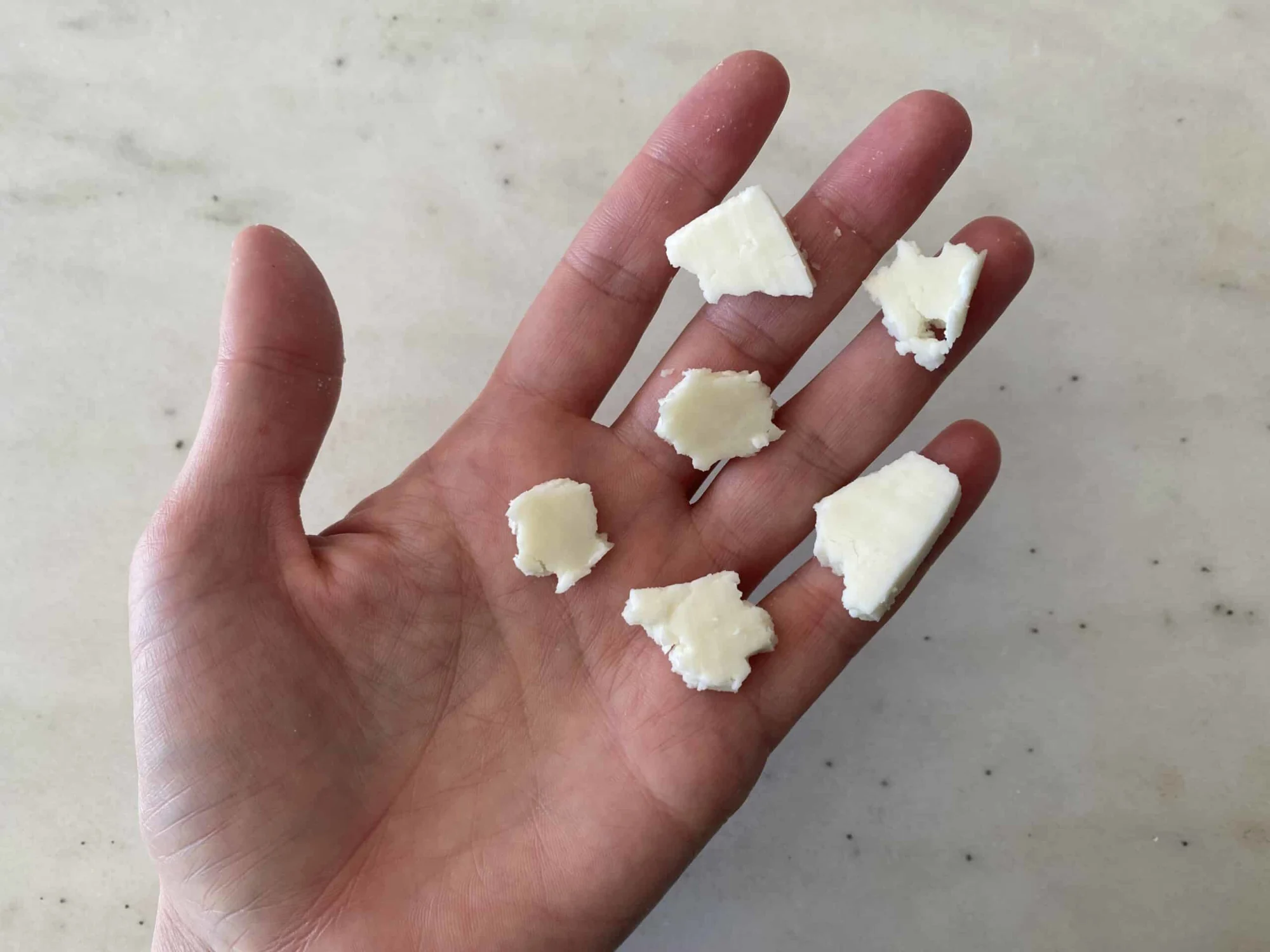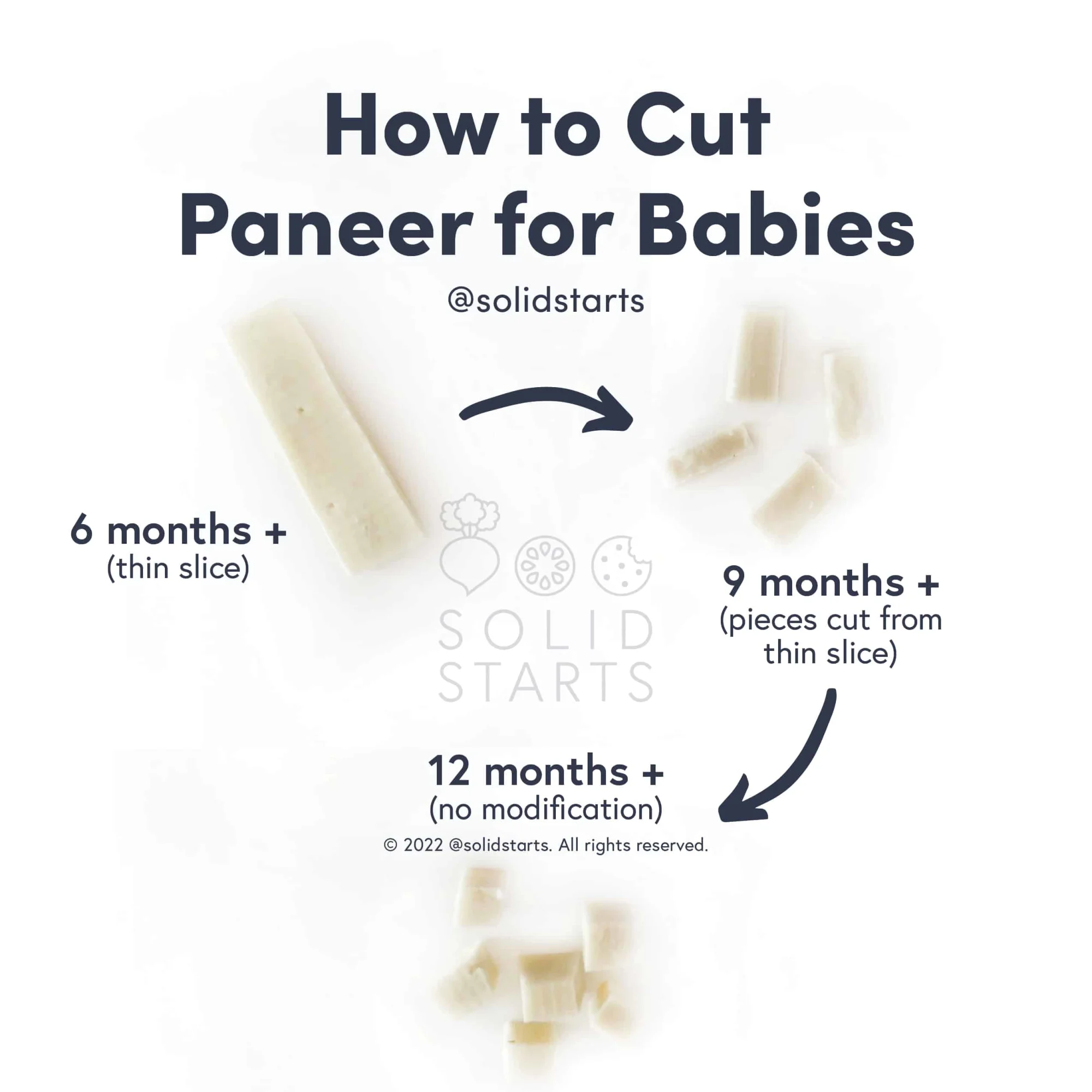Paneer
Dairy
Age Suggestion
6 months
Iron-Rich
No
Common Allergen
Yes

When can babies eat paneer?
Paneer may be introduced as soon as baby is ready to start solids, which is generally around 6 months of age. Traditional paneer contains no or low amounts of sodium, but make sure to read ingredient labels, as sodium is added to some commercial varieties and early and excessive exposure to sodium is thought to play a role in the possibility of hypertension and cardiovascular disease later in life.
Where does paneer come from?
Paneer is a fresh cottage cheese from the fertile lands that connect Europe, Africa, and Asia, where paneer (also called panira, penêr, pendir, peynir, and ponir) is made with the milk of buffalo, camel, cow, goat, sheep, or yak. Some versions are salted, others are not. Plant-based acids coagulate some types of paneer, while others contain rennet (animal-derived enzymes). In kitchens, markets, and restaurants worldwide, paneer often flavors dishes with roots in South Asia, where the fresh, unripened cheese is traditionally made from buffalo or cow milk curdled with lemon juice or vinegar. Its curds, called chhena, can be crumbled into fritters, grains, and salads, just like fresh goat cheese, fresh ricotta cheese, and queso blanco.
Videos
Is paneer healthy for babies?
Yes. Paneer is traditionally made from whole water buffalo milk, which is higher in fats and many other nutrients than cow’s milk. Even commercial varieties of paneer are often made from a combination of buffalo and cow milk, which reduces fat content but still provides plenty of the fats that babies need to build healthy cells and brain tissue at this early stage of life. By definition, paneer must be 50% fat. Paneer also contains a good amount of protein to build cells, tissues, organs, and more. Similar to other cheeses, paneer also offers significant amounts of calcium, folate, as well as some B vitamins, a bit of vitamin D, phosphorus, and zinc.
For more information on how much cheese babies can eat and other frequently asked questions, see our cheese page.
While many people make paneer at home, if you’re buying paneer to share with babies and toddlers, look for
Pasteurized
Made from whole milk (ideally)
Low sodium (less than 100 milligrams per serving)
★Tip: For those following vegetarian diets, check the label on paneer to see how it is made. Paneer is most often made with plant-based acid but can sometimes be made from animal-derived rennet.
Is paneer a common choking hazard for babies?
Yes, it can be. Cheese, especially in cube form, is a common choking hazard for babies and children. To reduce the risk, slice thinly, crumble, and avoid serving paneer in small cubes. If a dish already has cubed paneer, simply cut the cubes in half so they are thinner or mash with a fork. As always, make sure you create a safe eating environment and stay within an arm’s reach of baby during meals. For more information, visit our section on gagging and choking and familiarize yourself with common choking hazards.
Is paneer a common allergen?
Yes. Paneer is usually made from a blend of water buffalo milk and cow milk. Cow’s milk is a common food allergen in young children, accounting for about one-fifth of all childhood food allergies. Although allergies to water buffalo milk are less commonly reported, the allergenic proteins in buffalo milk are likely to cross-react with those in cow’s milk. Buffalo milk allergy in the absence of cow’s milk allergy is exceedingly rare. Keep in mind that dairy products from other ruminants such as sheep, goat, and buffalo may provoke similar allergic reactions to cow’s milk dairy products.
If your baby is allergic to cow’s milk, be reassured that it is an allergy that often disappears with time. Research shows that the majority of children with cow's milk allergy will outgrow it by age 6 and many babies with milder symptoms of milk protein allergy (which can show up as painless blood in stool) are able to successfully reintroduce cow's milk as early as their first birthday, with the guidance of their doctors.
While cow’s milk is recognized as a common cause of food protein-induced enterocolitis syndrome (FPIES), it is also recommended for babies with FPIES to milk to also avoid milk of other ruminants, such as buffalo. FPIES is a delayed allergy to food protein which causes the sudden onset of repetitive vomiting and diarrhea to begin a few hours after ingestion. Left untreated, the reaction can result in significant dehydration. Thankfully, like other forms of milk allergy, FPIES which presents early in life is generally outgrown by the time a child has reached 3-5 years of age.
While cheese is generally better tolerated by those with lactose intolerance, note that paneer can contain a moderate amount of lactose, so individuals with lactose intolerance can be sensitive to paneer. Keep in mind that lactose intolerance is uncommon for infants and toddlers. If your child is lactose-intolerant, it’s important to find calcium-rich foods to consume regularly to ensure a balanced diet and support bone health. Search for naturally low-lactose cheeses and dairy products labeled “lactose-free.”
If you suspect your baby may be allergic to dairy products, consult an allergist before introducing paneer. Based on your baby’s risk factors and history, your allergist may recommend allergy testing, or may instead advise dairy introduction under medical supervision in the office. If the risk is low, you may be advised to go ahead and introduce paneer in the home setting. As with all common allergens, start by serving a small quantity on its own for the first few servings, and if there is no adverse reaction, gradually increase the quantity over future servings.
Recommended Guide: Introducing Allergens
Can paneer help babies poop?
In general, cheese is relatively high in fat and low in fiber, qualities that slow the processes of digestion and pooping. Significant consumption of cheese and milk can be a contributing factor in constipation. That said, some paneer varieties contain probiotics which may help promote bowel regularity. Remember, pooping patterns can vary significantly from child to child. Be sure to talk to your pediatric healthcare provider if you have concerns about baby’s pooping and digestive function.
What are recipe ideas for cooking with paneer?
Paneer does not melt, which makes it a great cheese to use in soups, stews, and other hot dishes. It can be sliced into cubes to bake, grill, or skewer; crumbled over grains or vegetables; and mixed into eggy dishes, salads, stews, and stuffing. Bake paneer into bread, naan, or idli—the steamed lentil and rice cakes of India and Sri Lanka. Pair paneer with bold flavors in the wide array of dishes that bridge the diverse cultures of Eastern Europe and South and West Asia, from dals, curries, masalas, and pakora, to kibbeh, kofte, and pilafs. You can also use paneer in recipes that call for other cottage cheeses, like queso blanco crumbled on chili, elotes, and tacos, or ricotta cheese in crepes, pierogi, or stuffed pasta.
How do you introduce paneer to babies with baby-led weaning?
Every baby develops on their own timeline, and the suggestions on how to cut or prepare particular foods are generalizations for a broad audience.
6 to 9 months old:
Serve paneer sliced into long rectangles about the size of two adult fingers pressed together or mash for hand scooping. You can also serve paneer cooked into curries, dals, or stewed vegetables as long as the cheese is crumbled, cut into thin pieces, or pulled into shreds. Avoid paneer cut into small cube shapes, as they present a higher choking risk. Alternatively, fold chhena or crumbled paneer into foods that are easy for baby to grab and munch, like bean balls, fritters, idli, or kofta. Hold off on sugar for now and wait to serve sweets made with chhena and paneer until after the first birthday.
9 to 12 months old:
At this age, babies start to develop their pincer grasp, where the thumb and pointer finger meet. When you see signs of this development, try moving down in size to bite-sized pieces of paneer (about the size of a large adult knuckle) or crumbled paneer. Offer paneer on its own, or in curries or dal seasoned with your family’s favorite spices.
12 to 24 months old:
Paneer offers a great texture for utensil practice for toddlers. Serve cubes or matchsticks of paneer with an age-appropriate fork and let the child try to self-feed, pre-loading the utensil if the child needs help. When offering these larger pieces of paneer, stay close in case help is needed and model how to take bites by eating your meal alongside the child. If larger pieces of food make you nervous, continue to offer bite-sized pieces or crumbled paneer, using the cheese as a gateway to new flavors from seasonings and spices. At this age, you can share sweets made with chhena or paneer with toddlers. Just aim to serve them in small amounts and on occasion to minimize added sugars in the child’s diet.


For more on which cheeses are best for babies—and which should be avoided—see our Cheese page.
Written and reviewed by these specialists
J. Truppi, MSN, CNS. Certified Nutrition Specialist®
V. Kalami, MNSP, RD, CSP. Board-Certified Pediatric Dietitian and Nutritionist.
K. Tatiana Maldonado, MS, CCC-SLP, CBIS, CLEC. Pediatric Feeding Therapist.
K. Grenawitzke, OTD, OTR/L, SCFES, IBCLC, CNT. Pediatric Feeding Therapist.
S. Bajowala, MD, FAAAAI. Board-Certified Allergist & Immunologist (allergy section)
R. Ruiz, MD, FAAP. Board-Certified General Pediatrician & Pediatric Gastroenterologist
Expert Tips Delivered to Your Inbox
Sign up for weekly tips, recipes and more!
The content offered on SolidStarts.com is for informational purposes only. Solidstarts is not engaged in rendering professional advice, whether medical or otherwise, to individual users or their children or families. No content on this site, regardless of date, should ever be used as a substitute for direct medical advice from your doctor or your medical or health professional, nutritionist, or expert in pediatric feeding and eating. By accessing the content on SolidStarts.com, you acknowledge and agree that you are accepting the responsibility for your child’s health and well-being. In return for providing you with an array of content “baby-led weaning” information, you waive any claims that you or your child may have as a result of utilizing the content on SolidStarts.com.



